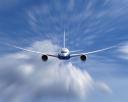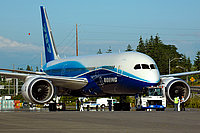It looks like airlines around the world are starting to have enough of the recent delays from aircraft manufacturers while they are developing new airliners. The Airbus A380 was late by 1.5 years, Sukhoi’s SuperJet is also well behind schedule, not to mention Boeing’s troubled 787 Dreamliner, latest hit by the machinist’s/assembly workers’ 2 month strike last fall.
 S7 Airlines, Russia’s biggest domestic airline is the first airline to have confirmed the cancellation of its full order for 15 Boeing 787 Dreamliners. As widely known, Boeing’s promising new Dreamliner has not flown yet, and is more than 2 years behind the original schedule. The first plane should have been delivered to All Nippon Airways last year, before the 2008 Beijing Olympics, but the plane has yet to take to the skies for the first ime. S7 is the first carrier to actually terminate a major deal for Boeing’s next generation widebody airplane.
S7 Airlines, Russia’s biggest domestic airline is the first airline to have confirmed the cancellation of its full order for 15 Boeing 787 Dreamliners. As widely known, Boeing’s promising new Dreamliner has not flown yet, and is more than 2 years behind the original schedule. The first plane should have been delivered to All Nippon Airways last year, before the 2008 Beijing Olympics, but the plane has yet to take to the skies for the first ime. S7 is the first carrier to actually terminate a major deal for Boeing’s next generation widebody airplane.
The May 2007 order placed for 15 787s, due to be delivered in 2014, was worth about USD$2.4 billion at list prices and also included 10 purchase rights. The cancellation is a blow for Boeing, as other customers standing in line for the Dreamliner and simply acknowledging each news about further delays (the manufacturer has delayed the 787 program five (!) times already) may get powered up and decide to also cancel their orders. The current financial crisis is hitting practically all airlines around the world really bad, thus cost-cutting is vital for them. And Boeing running so much behind its schedule and not fulfilling its contractual duties, is in a bad position to protect and save these deals, while airlines may see 787 Dreamliner order cancellations as an effective way of saving some money in these hard times.

The order is gone, but we may still see the Boeing 787 Dreamliner in S7 livery
The airline (formerly known as Siberia Airlines), did not offer a reason for the cancellation but said in a statement that it “retains interest in using the Dreamliner and at the moment is looking into receiving the planes under a leasing scheme at an earlier date, for which it is in negotiations with several leasing companies.”
Boeing’s 787 backlog now stands at 895 from 58 customers. Overall, it has taken 914 gross orders for the Dreamliner. In addition to the S7 cancellation, Xiamen Airlines in 2006 replaced an order for three 787s with an order for seven 737-800s and Azerbaijan Airlines replaced one 787 with one 767-300ER last summer.
Boeing has originally planned to deliver around 100 787s in 2009…





 basic proof of this idea is the fact Ryanair has already ordered 130 of these and apparently they will change their complete fleet and use only 787s. A 380s were ordered only by airlines with massive long haul surprised to read it
basic proof of this idea is the fact Ryanair has already ordered 130 of these and apparently they will change their complete fleet and use only 787s. A 380s were ordered only by airlines with massive long haul surprised to read it